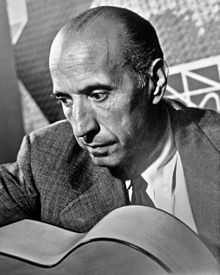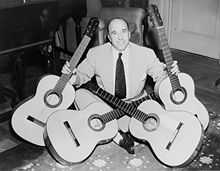Carlos Montoya
| Carlos Montoya | |
|---|---|
 | |
| Background information | |
| Birth name | Carlos García Montoya |
| Born | 13 December 1903 |
| Origin | Madrid, Spain |
| Died | 3 March 1993 |
| Genres | Flamenco music |
| Occupation(s) | Composer, Guitarist |
| Instruments | Guitar |
Carlos García Montoya (13 December 1903 – 3 March 1993) was a prominent Flamenco guitarist and a founder of the modern-day popular Flamenco style of music.[1]
His unique style and successful career, despite all odds, have left a great legacy for modern day Flamenco. It is because of his pioneering work in popular Flamenco music that have allowed other great modern groups such as the Gipsy Kings to take hold in all parts of the world. A few of his video recordings can still be found on YouTube.
Biography
Carlos Montoya was born in Madrid, Spain, on 13 December 1903. As the nephew of renowned flamenco guitarist Ramón Montoya, he seemed to have been born to play Flamenco, but it was his uncle who would be his biggest obstacle, as he refused to teach Carlos the tricks of the trade. He first learned from his mother, "la Tula", and then from a neighboring barber, Pepe el Barbero, i.e. Pepe the Barber. After one year Pepe said there was nothing more he could teach his talented pupil, so Carlos left to gain what he could from the great Flamenco guitarists of the time. At fourteen he was playing in the "cafes cantantes," in the heyday of Flamenco singing and dancing, for such fabulous artists as Antonio de Bilbao, Juan el Estampío, La Macarrona and La Camisona in Madrid, Spain.
In the 1920s and 1930s he performed extensively in Europe, North America, and Asia with the likes of La Teresina. The outbreak of World War II brought him to the United States where he began his most successful days as a musician, and frequently toured with the dancer La Argentina. Settling in New York City during World War II (circa 1941), he began touring on his own, bringing his fiery style to concert halls, universities, and orchestras. During this period he made a few recordings for several major and independent labels including RCA Victor, Everest and Folkways.
Montoya toured year round but always returned to his homeland, Spain, to spend the Christmas holidays with his family.
His style was not particularly appreciated by some serious flamenco students, who considered it less brilliant than many others, including that of Montoya's uncle Ramón. Carlos's own favorite flamenco guitarist, it was reported by Zern, was the obscure Currito de la Geroma. That he was unpopular among aficionados was largely because Montoya learned in a non-traditional way and that he abandoned the compás which has evolved within flamenco over hundreds of years. Many of his works do not even keep perfect tempo, increasing and decreasing in speed almost whimsically. He was admired for the speed of his picados and undoubtedly found popularity on the international stage as a result of this technically impressive pace. .
Montoya died on 3 March 1993 at the age of 89 of heart failure in Wainscott, New York, on Long Island.
Discography

| Year | Album Title | |
|---|---|---|
| 1950 | Spanish Guitar Solos | |
| 1957 | Flamenco Guitar | |
| 1958 | Flamenco Fire | |
| 1959 | From St. Louis to Seville | |
| 1961 | Malaguena | |
| 1961 | Carlos Montoya and His Flamenco Guitar | |
| 1963 | Flamenco Antiguo | |
| 1964 | Flamenco Concert | |
| 1967 | The Artistry Of | |
| 1996 | Flamenco! | |
| 2004 | Guitar & Flamenco |
Filmography
- Carmen, la de Triana (1938)
References
External links
- Some photos of LP covers (Oviatt Library Digital Collections)
|